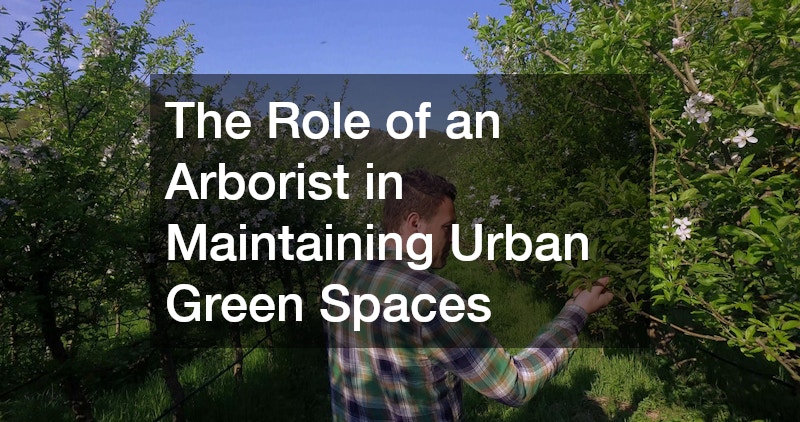As Australian cities grow and densify, urban green spaces have become vital oases of biodiversity, environmental health and community wellbeing. Parks, street trees, public gardens and rooftop greenscapes provide much-needed relief from concrete-heavy landscapes, reduce urban heat, improve air quality and promote mental health. But these benefits don’t occur without care and planning. At the heart of maintaining these green lungs lies a highly skilled professional — the arborist.
An arboriculturist is a trained specialist in the care, management and study of trees. Their role in urban settings is critical, as they balance tree health with public safety, support local ecosystems and ensure green infrastructure can thrive amid the pressures of city life.
Tree Health & Longevity
Urban environments can be harsh on trees. Soil compaction, limited root zones, air pollution and restricted access to water and nutrients all contribute to declining tree health. An arboriculturist assesses these conditions and applies expert knowledge to support tree vitality. Through pruning, soil conditioning, pest management and structural support, they can significantly extend the life of a tree while preventing costly damage or removal.
Their work begins with regular inspections. Using visual assessments and specialised equipment, an arboriculturist can detect early signs of disease, decay or infestation. Rather than a reactive approach to tree failure, this preventive maintenance keeps trees robust and resilient. In many council areas across Australia, they are essential for implementing tree preservation orders and urban canopy strategies, ensuring heritage and high-value trees are safeguarded for future generations.
Promoting Public Safety
While trees provide immense benefits, they can also pose hazards if not properly maintained. Falling branches, root heave and weakened trunks are just a few of the risks associated with ageing or neglected trees. An arborist is trained to assess structural stability and mitigate risks without unnecessarily removing healthy trees.
In high-traffic areas such as schools, parks or road corridors, they play a crucial role in ensuring tree safety without compromising the integrity of the landscape. Pruning techniques, such as crown thinning or deadwood removal, can reduce weight and improve wind resistance, making trees safer during storms or extreme weather events.
Moreover, when removal is unavoidable, foresters carry out the task in accordance with local regulations and environmental best practices. They also advise on suitable replacement species that align with council planting guidelines, biodiversity targets and urban design.
Enhancing Biodiversity & Ecosystem Services
Urban green spaces support a surprising array of wildlife — from native birds and pollinators to microbats and possums. Trees are at the centre of this ecosystem, providing food, shelter and habitat connectivity. An arborist’s work directly influences the ecological value of these spaces.
By selecting and caring for appropriate tree species, foresters contribute to biodiversity conservation in city environments. They also design pruning schedules that avoid nesting seasons, helping protect vulnerable species. Where possible, tree experts will preserve habitat trees, which provide hollows essential for native fauna.
In addition to wildlife benefits, trees also offer ecosystem services such as carbon sequestration, stormwater management and air purification. A well-maintained urban canopy can significantly lower ambient temperatures and reduce energy costs. The expertise of an arboriculturist ensures that these services are optimised and sustained, making cities more liveable and climate-resilient.
Strategic Planning & Urban Forestry

Tree experts are increasingly involved in strategic urban planning. Their input is critical in development applications, infrastructure design and public space upgrades. For instance, before construction begins on roads or buildings, an arboriculturist conducts tree impact assessments to identify vegetation at risk. They then develop tree protection plans that allow development to proceed while preserving valuable greenery.
Some arboriculturists also work within urban forestry teams, helping councils plan long-term canopy targets and species diversification. This strategic approach ensures the urban forest remains healthy and adaptable in the face of changing climate conditions, pest incursions and population growth.
Urban greening initiatives, such as Melbourne’s Urban Forest Strategy or Sydney’s Greening Our City program, rely heavily on tree surgeons’ expertise. Their knowledge helps inform where trees should be planted, what species to choose and how to ensure their survival in constrained urban spaces.
Urban green spaces are essential assets that require expert care to flourish. The arboriculturist plays a vital role in maintaining the health, safety and sustainability of urban trees across Australia. Their skills extend far beyond pruning — encompassing biodiversity support, strategic planning, risk mitigation and public engagement.
As cities grow and face increasing environmental pressures, the arborist will remain an indispensable guardian of green infrastructure. Investing in their expertise is not just about tree care — it’s about creating cleaner, safer and more liveable urban environments for all.
